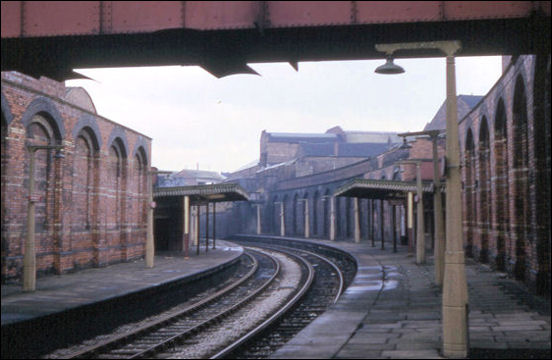|
Hanley
on the Potteries Loop Line
  
click the
"contents" button to get back to the main index
next: Etruria on the Loop Line
previous: Cobridge on
the Loop Line
|
Historian Fred Hughes
writes....
“Forty-odd years ago Hanley was undeniably the city centre,” declares
Potteries historian Steve Birks. “And I reckon you can add without much
argument that it was the Loop Line that made Hanley into the city centre.
You could get to Hanley Station from anywhere in Britain ending up on the
doorstep of the luxurious Grand Hotel. From here a visitor could shop at
several major department stores, or get drunk in one of a dozen pubs. Or
go to the theatre or visit a clutch of cinemas; all within stepping
distance of the station.”
The Loop
from the north emerged out of a 300-yard long tunnel at Cobridge.
“This
section to Hanley Station was a thousand yards long, not as the crow
flies, but as the snake twists and winds. It was on this stretch that
little Waterloo Road station was opened in 1900. It was the last Loop Line
station to be built and the first to close,” says Steve.
Arnold
Bennett has The Old Wives’ Tale sisters riding the Loop Line with Sophia
and Constance Baines noting the new buildings and the remembered
landmarks.
“It was surprising how little the district has altered,” said Sophia, as
the train puffed under Trafalgar Road. She pointed to a new station that
was being built to be called Trafalgar Road station. “Won't it be
strange?” she said of the new Loop Line halt, “A Trafalgar Road inserting
itself between Bleakridge and Hanbridge.”
|
Chris
Barnett was born in York Street Hanley. His playground lay between Hanley
Station and Waterloo Road Station.
“I lived
here until I was eight before we moved to Smallthorne,” he recalls. “It
was a massive community – street after street of terraced houses with
pubs, schools and corner shops wedged between gloomy potbanks and the
seemingly endless Walker’s oil refinery.”
Brothers
William and John Walker began their business in 1874 after discovering the
significance of tons of commercially exploitable deposits of crude oil in
the coal seams of Hanley Deep and Grange Collieries.
“The
brothers profited when they shifted from domestic production to industrial
lubrication. They took the name Century in 1900 to match their success to
the new era,” says Steve. “Walker’s were pioneers in industrial machinery
lubrication and introduced superior motor oils, lubricating greases and
fire-resistant hydraulic fluids. The company was helpfully provided with
coal from the collieries and had an important neighbouring customer in
Shelton Bar. The mineral lines that interweaved the Loop Line were
essential to business and their tar wagons were a common sight on goods
trains.” |
Chris
agrees to guide me along what’s left of the stretch between Waterloo Road
and Hanley stations.
“The Loop
Line went under another tunnel below Waterloo Road at Granville
Crossings,” says Chris. “Nearby was a wrought-iron foundry called
Howlett’s, a family firm that owned many York Street houses, one of which
we rented. Alongside were a GPO depot and a former bus garage. The line
twisted and turned snaking all the way into Hanley Station. In fact there
wasn’t a straight stretch between the two stations except when it crossed
over the bridge at Century Street.”

the bridge carried the
railway track of the Potteries Loop Line
Brook Street (now Century Street) around 1890
It’s
possible still to see the buttresses that supported this 46-foot long
bridge, the longest on the entire length of the Loop Line.
“My first
train journey was from Hanley Station to Blackpool with the Workingmen’s
Club annual outing,” recalls Chris. “I was about six when this trip took
place yet I can remember it as if it was yesterday. I recall there were
two tank engines pulling the train because it was impossible to get
anything bigger than what’s known as a ‘black 5’ engine around the tight
curves. The tank engines pulled the carriages to Etruria where they
connected to a bigger engine that ran to Blackpool. Hanley station was so
constricted that check-rails were installed because anything bigger than a
57-foot carriage would scrape the edges of the platform.”

Hanley station "in a deep
cutting and on a very sharp curve"
photo: Trevor Ford - taken in the early 1960's not long after the line
closed
photo looking towards Cobridge
Standing
on the car park of the Quality Hotel it is impossible to imagine there was
once a busy station here.
“It took
a while to clear the site,” says Chris. “After the station closed the
goods buildings were used as workshops and storage. One part of it even
became a nightclub called Zambezi. Ultimately later owners of the Grand
Hotel filled-in the station and built the car park over it. But you can
still see the half-buried blue-brick arches that were on the far side of
the station. Twenty-five feet beneath this is the Loop Line northbound
platform. And where the bricks have been removed you can still see part of
the struts that supported the station canopy.”
It’s amazing that these canopy struts and the tops of the arches have
remained as accidental fragments of railway history. The parapet of the
bridge that passed under Trinity Street is also there as is the retaining
wall on the other side where the first Hanley Station was built before the
Loop. From here the curve swings south beside Clough Street car park and
on through Tinkersclough to Etruria.
 more on Hanley on the loop line
more on Hanley on the loop line |
![]()
![]()
![]()